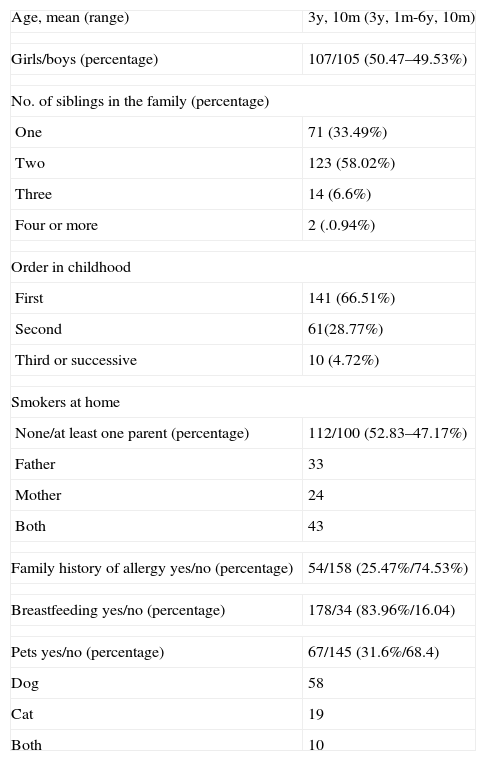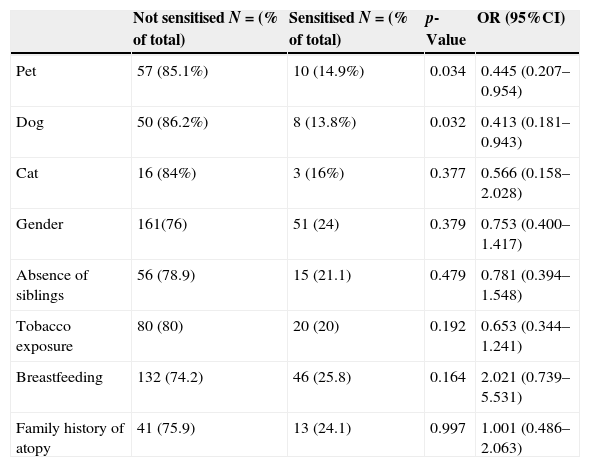An increase in the prevalence of asthma, rhinitis and eczema as paradigms of atopic diseases in children has been well documented.1 In Spain, the prevalence of asthma and rhinitis has also increased, especially among small children, during the last decades.2
Many studies have tried to establish a relationship between different environmental exposures in the first year of life and the risk of developing allergic disease both in children3,4 and in adults.5 Only a few studies have tried to identify a relationship between environmental exposure and the risk of sensitisation,6,7 with no consistent results.
The aim of this study is to establish a possible relationship between pet keeping during the first year of life and the risk of sensitisation to house dust mite, cat and dog allergens in preschool children.
Children aged 4 and 5 years attending public schools in Estepona (Málaga, Spain) were invited to join the study during the school years 2006–2007 and 2008–2009. Participation varied widely among centers from 25% to 100%. Parents of the participants answered a questionnaire modelled on the International Study of Asthma and Allergies in Childhood (ISAAC) format,8 validated for the Spanish population,9 and slightly modified to avoid the questions related to the progression of allergic diseases.
The study was approved by the local and regional educational authority, and written consent was obtained from all parents.
Skin prick tests were performed using the method described by the European Academy of Allergology and Clinical Immunology (EAACI).10Dermatophagoides pteronyssinus, Dermatophagoides farinae, cat dander and dog dander were tested.
Statistical analyses were performed using PASW Statistics 18 [(formerly SPSS)© 2009 SPSS Ibérica, IBM Company]. Numerical variables were expressed as medians and ranges. Categorical variables were analysed by a chi-squared test. The independent influence of these parameters was studied by univariate logistic regression and multivariate logistic regression analysis when needed, and was quantified by the odds ratio (OR) and 95% confidence interval (95%CI).
A total of 374 children were potentially eligible for inclusion in the study. Of these, 212 completed the clinical evaluation.
Characteristics of the evaluated children are shown in Table 1.
Socio-demographic characteristics of subjects participating.
| Age, mean (range) | 3y, 10m (3y, 1m-6y, 10m) |
| Girls/boys (percentage) | 107/105 (50.47–49.53%) |
| No. of siblings in the family (percentage) | |
| One | 71 (33.49%) |
| Two | 123 (58.02%) |
| Three | 14 (6.6%) |
| Four or more | 2 (.0.94%) |
| Order in childhood | |
| First | 141 (66.51%) |
| Second | 61(28.77%) |
| Third or successive | 10 (4.72%) |
| Smokers at home | |
| None/at least one parent (percentage) | 112/100 (52.83–47.17%) |
| Father | 33 |
| Mother | 24 |
| Both | 43 |
| Family history of allergy yes/no (percentage) | 54/158 (25.47%/74.53%) |
| Breastfeeding yes/no (percentage) | 178/34 (83.96%/16.04) |
| Pets yes/no (percentage) | 67/145 (31.6%/68.4) |
| Dog | 58 |
| Cat | 19 |
| Both | 10 |
Symptoms related to asthma were found in 104 children (49.06%). Of these cases, 68 (32.08%) were classified as transient wheezing and 36 (16.98%) as asthma. Symptoms related to rhinitis were found in 61 children (28.77%) and to eczema in 65 (30.66%).
The ISAAC in Spain found symptoms related to asthma in 9.5% of the cases, symptoms related to rhinitis in 7.9%, and eczema in 5.9%.
The observed differences could be related to age. The mean patient age in our study was 3 years and 10 months, instead of 6–7 years of the ISAAC. Upper respiratory tract infections, more frequent in younger children, could be easily confused with symptoms related to asthma or rhinitis.
The observed differences could also be related to geographical variations. Mediterranean seaside cities participating in the ISAAC have similar prevalences. Cartagena reported symptoms related to asthma in 33.2% of the cases and symptoms related to rhinitis in 21.3%. Almería in turn reported asthma in 14.5%, symptoms related to rhinitis in 38.9%, and eczema in 23.4%.11
The overall prevalence of allergic sensitisation was 26.42%. House dust mites accounted for 24.05%, dog dander 6.59%, and cat dander 3.29%.
Similar rates were found in the ISAAC Phase II, with a sensitisation rate of 36.2% to house dust mites and 10.8% to cat dander in 10- and 11-year-old children in Almería.12 A study in teenagers in Malaga found sensitisation to house dust mites in 30%.13
Of the 212 families studied, 67 (31%) had pets. In the families with no pets, 28.3% of the children were sensitised. When at least one pet was present, the sensitisation rate decreased to 14.9%.
Univariate analysis using the chi-squared test was performed with exposure to pets, exposure to dogs and cats separately, the absence of siblings, a family history of asthma, exposure to tobacco and breastfeeding as risk factors of sensitisation to house dust mites. The same was performed with exposure to pets, dogs and cats as risk factors of sensitisation to pets, dogs and cats.
The factors significantly associated to sensitisation to house dust mites were exposure to pets (OR 0.44; 95%CI 0.20–0.95; p=0.034) and exposure to dogs (OR 0.41; 95%CI 0.18–0.95; p=0.032). Exposure to cats showed a pattern of decreasing sensitisation similar to that observed for house dust mites, although the association failed to reach statistical significance (OR 0.56; 95%CI 0.15–2.02; p=0.37).
No associations were found between the other factors analysed and the risk of sensitisation to house dust mites (Table 2).
Factors linked to sensitisation to house dust mites assesed by univariate logistic regression.
| Not sensitised N=(% of total) | Sensitised N=(% of total) | p-Value | OR (95%CI) | |
|---|---|---|---|---|
| Pet | 57 (85.1%) | 10 (14.9%) | 0.034 | 0.445 (0.207–0.954) |
| Dog | 50 (86.2%) | 8 (13.8%) | 0.032 | 0.413 (0.181–0.943) |
| Cat | 16 (84%) | 3 (16%) | 0.377 | 0.566 (0.158–2.028) |
| Gender | 161(76) | 51 (24) | 0.379 | 0.753 (0.400–1.417) |
| Absence of siblings | 56 (78.9) | 15 (21.1) | 0.479 | 0.781 (0.394–1.548) |
| Tobacco exposure | 80 (80) | 20 (20) | 0.192 | 0.653 (0.344–1.241) |
| Breastfeeding | 132 (74.2) | 46 (25.8) | 0.164 | 2.021 (0.739–5.531) |
| Family history of atopy | 41 (75.9) | 13 (24.1) | 0.997 | 1.001 (0.486–2.063) |
Logistic regression analysis was used to identify confounding variables in the relationship between pet exposure and risk of sensitisation. After reviewing gender, the absence of siblings, tobacco exposure, breastfeeding and a family history of atopy, none were identified as confounding variables.
When categories were considered separately, interaction was suspected for some risk factors and was confirmed for the absence of siblings. While the risk of sensitisation to house dust mites when the child had a pet was OR 0.44 (95%CI 0.20–0.95; p=0.034), when the child had no siblings and also had a pet, the risk was even lower (OR 0.22; 95%CI 0.72–0.67; p=0.008).
The presence of dogs or cats in the home did not modify the risk of sensitisation to these animals. Seven children were sensitised to cat, although only one of them (5.6%) had a cat at home. In turn, 13 children were sensitised to dog, but only three of them (5.1%) had a dog at home. Statistical significance could not be demonstrated.
In seeking a possible relationship between pet keeping during the first year of life and the risk of sensitisation to house dust mite, cat and dog allergens in preschool children, we found exposure to pets in the first years of life to be protective against sensitisation to house dust mites. This effect was greater in children who had no siblings, and was not modified by other risk factors such as gender, a family history of atopy, tobacco exposure or breastfeeding. On the other hand, exposure to pets did not modify the risk of sensitisation to these animals.
As with all observational research, these results need to be interpreted with caution. In cross-sectional studies of this kind, sensitisation and covariates are measured at a single moment in time. The results of large birth cohort studies with prospective and objective measures of environmental exposure are required before the association between pets and atopy can be firmly defined.
Ethical disclosuresConfidentiality of dataThe authors declare that they have followed the protocols of their work centre regarding the publication of patient data, and that all the patients included in the study have received sufficient information and have given informed consent in writing to participate in the study.
Right to privacy and informed consentThe authors declare that no patient data appear in this article.
Protection of human subjects and animals in researchThe authors declare that no experiments were performed on humans or animals for this investigation.
Conflicts of interestThe authors have no conflict of interests to declare.






